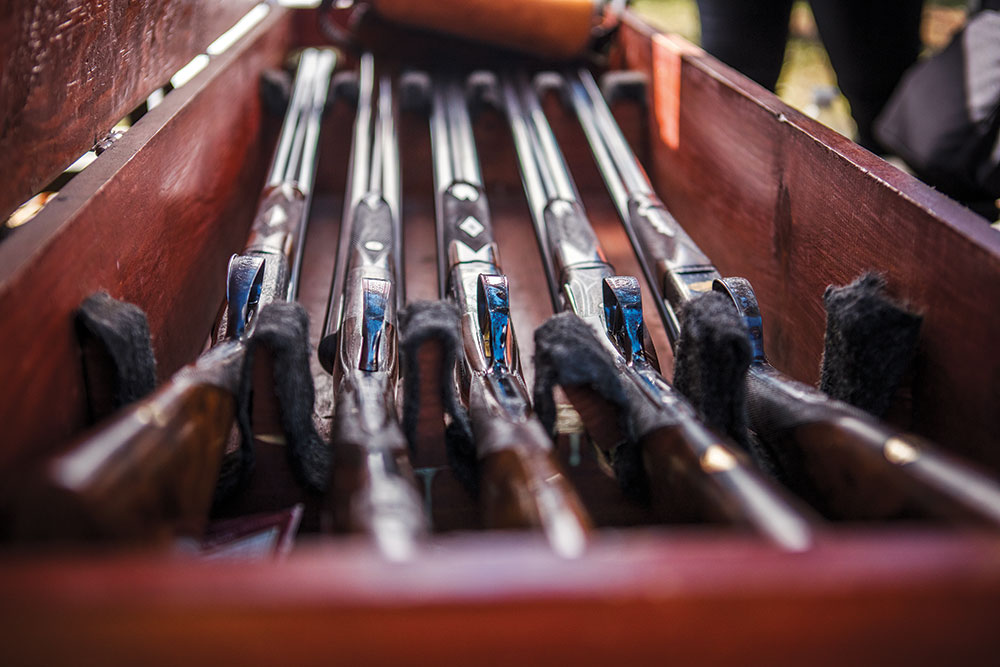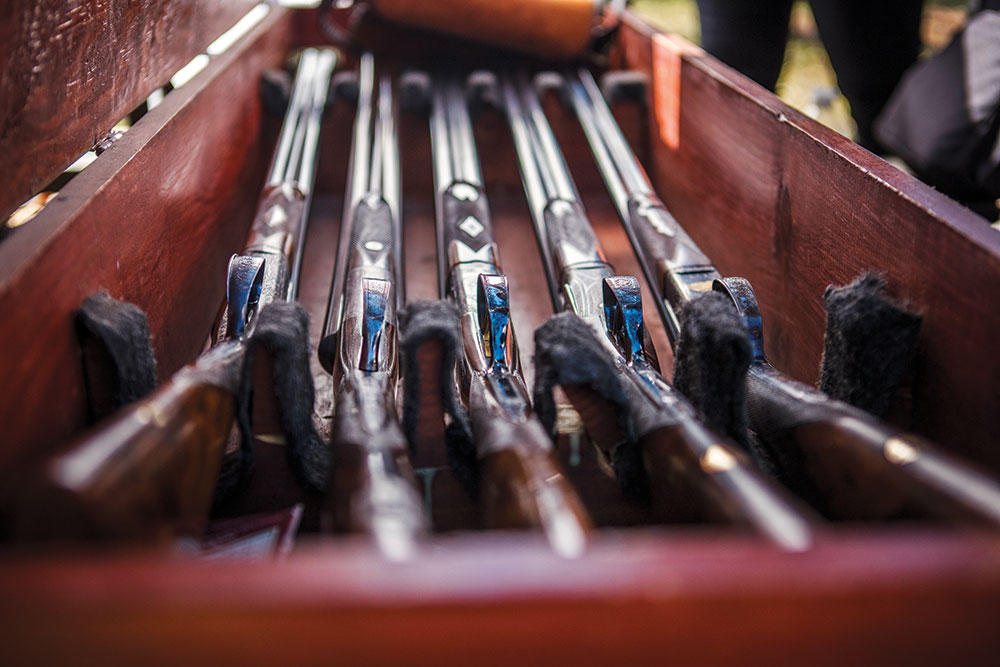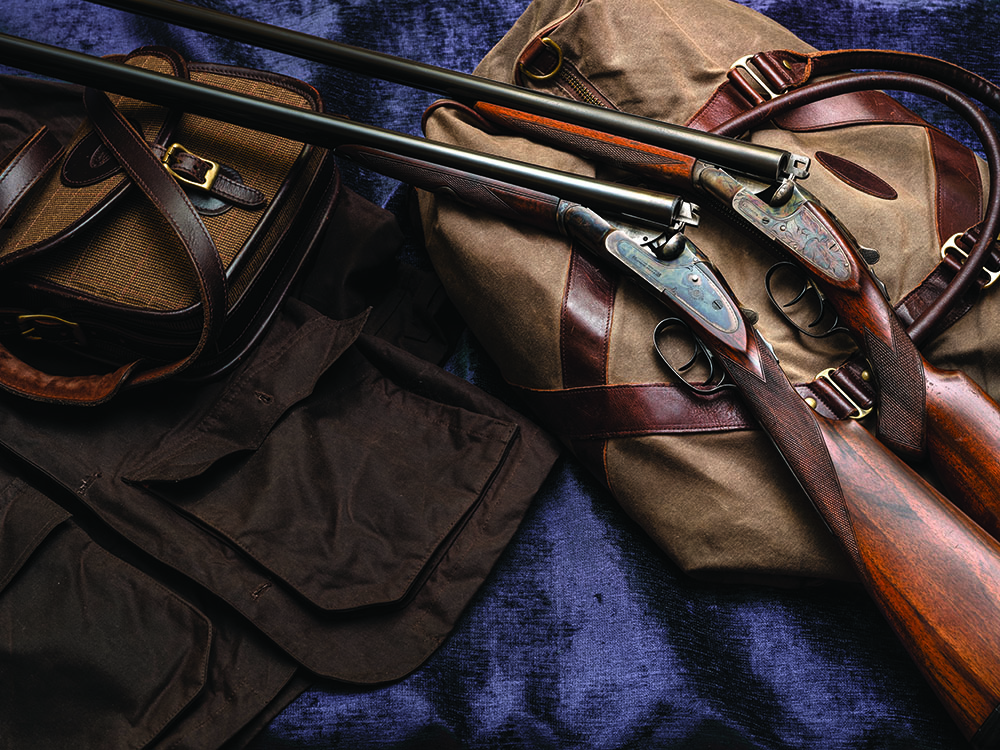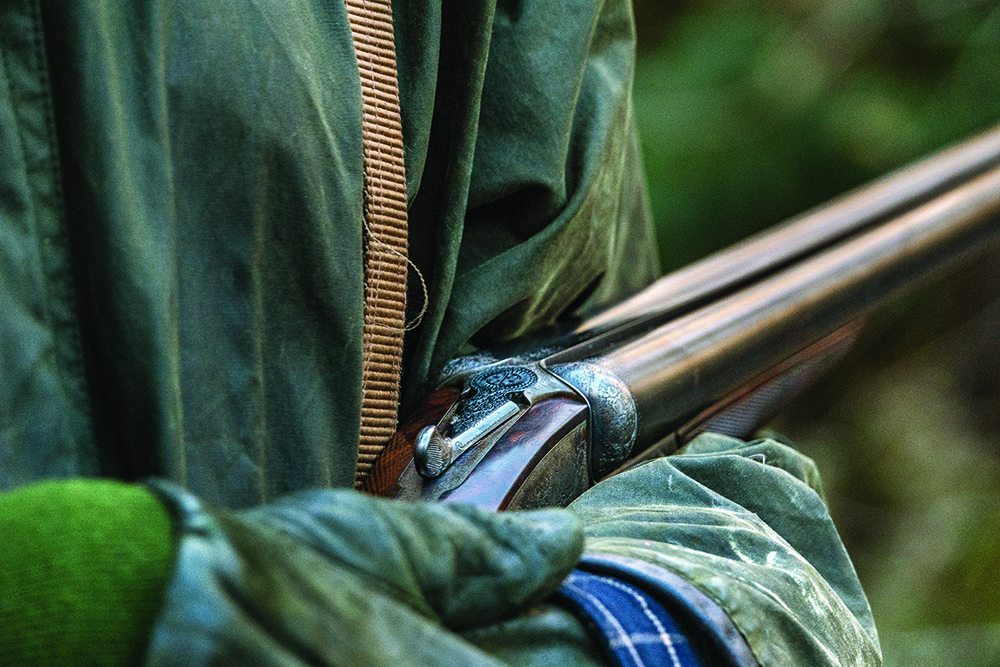A Call to Arms

Almighty Circassian walnut tree succumbed to the process of nature 300 years after sprouting from the earth. Its fallen fruit and leaves piled beneath it and fed the soil for the next seedling. Its barer branches during spring signaled the axmen to harvest the wood, and while most of the felled tree was milled into planks of lumber, another team extracted its root ball—the soul of the Circassian. The root ball kept a record of every season weathered by the tree, and its grain accumulated distinct marbled figuring from the soil nutrients and the elements it endured. It was chaptered into large wooden blanks and dried for almost a decade. The choicest pieces were selected, and they became the stocks and fore-ends of the world’s finest firearms. Artisans at each successive stage of forging these fine guns spared no effort in their creation and parted ways with pieces of their soul. When the spirit of the Circassian met the collective fruit of their labor, the resulting double gun became more than a firearm. It became a conduit between past and present—a tactile piece of human history and functional art.

Few trades perfected in the 19th and early 20th Centuries still persist today, and double-gun craftsmanship is one of them. Collectors of contemporary bespoke guns keep this rich tradition alive by commissioning new pieces, but collectors of antique double guns also perform a vital role to the gun trade by keeping and maintaining pieces from the past. Once these guns pass from the artisan hands that built them, the lineage of craftsmanship and labor poured into them might be lost to the world if not for antique double-gun collectors. They curate their collections around one or several sources of fondness for these deadly beautiful works of art. The storied history of a particular maker might inspire them or perhaps the exquisite artistry of a lauded engraver. Or it’s the feeling they get from taking afield a classic gun that has harvested more game than many might see in a lifetime. Any and all of these aspects, and several more, motivate collectors of antique double guns.
Like the Circassian walnut worn by the guns they adore, collectors pass through different phases and seasons of their lives, and their collections grow stronger as they part with pieces of lesser importance to them to acquire those of higher quality, rarity, or historical significance. At the height of a collector’s maturity, they acquire each piece of their collection with meticulous purpose and intent. It should be noted that a collector might build a large collection over time but owning an obscene number of antique firearms does not make a collector. Choosing the right pieces for a collection requires rigorous study, and the number of books in the libraries of many collectors far exceeds the number of guns they own. Though some collectors enjoy the spotlight, many prefer privacy—and with good reason. After several years in the world of collecting, many of them acquire magnificent pieces of extraordinary appraised value. Those herein opining on the art of gun collecting are generically referenced to protect their anonymity while delivering a characterization of the people behind the passion.

THE AGRARIAN This retired dairy farmer—we’ll call him “Raymond”—grew up shooting a Savage Fox Model B, and though he still owns his yeoman double gun, it shares space with a more handsome collection of classic American doubles from the early 20th Century. “I justified collecting classic American doubles about 20 years ago as an investment. But truthfully, they’ve not increased much in value, and I suppose a fella can justify accumulating anything he wants badly enough. Fortunately, I haven’t lost any money in ‘em,” he joked.
Raymond’s Fox Model B and his father’s Belgian Browning A-5 got the job done, but he pined for the experience of owning and carrying afield an antique side-by-side from the Golden Age of American double guns. He studied for several years before making his inaugural purchases saying, “I read every piece of literature I could get my hands on and talked with established collectors. You’ve gotta be careful and knowledgeable before starting a collection.” He also connected with gunsmiths who could keep his pieces serviceable and advises anyone interested in collecting and using antique double guns to do the same.
Raymond most enjoys quail hunting these days, and though a 20-bore specialty grade L.C. Smith sees more action than his other pieces, Raymond focuses his collection on Parker Brothers sub-gauges that he intends to use. “I don’t buy guns that I don’t shoot, and since I use the pieces from my collection, I don’t acquire guns that lose value from being afield,” he explained. The strength and durability of classic American double guns endears them to many collectors in the United States. It’s common to find wingshooters harvesting game with them after more than a century of regular use—some of them being family heirlooms still up to the task of being afield. After antique double guns pass from the hands that built them, they add chapters to their stories with each successive owner. The worn finish of their barrels, the faded checkering on their stocks, and their rich perfume of leather and bore solvent chronicles their journeys. For these reasons, restoration under most circumstances is discouraged in the world of gun collecting. However, there comes a time when a decision must be made to rescue a double gun or resign it to the parts bin.
While acknowledging the patina is part of the allure, Raymond makes a case for restoration in specific instances saying, “If you’ve got a piece that’s functional and with wood and metal that are 50-percent condition, I wouldn’t tamper with it. But if the metal and wood are in poor condition and the gun doesn’t function, I would consider restoring it only if it’s a rare piece or a family heirloom.” He restored a Parker “Double- O” frame in 28-gauge with 24-inch barrels because the gun was in poor condition, and few of them were made. “It’s probably worth $3,000 more than I have in it, but this was an exceptional case. More often than not, you can’t create value in a gun through restoration.” Another case he would make for restoration would be finding a Parker Brothers .410 in any grade. “I toyed with the idea of having one built, but the expense of that project would break my rule of never owning a gun I don’t intend to shoot.”

THE ANGLOPHILE Upon having the pleasure of meeting this collector—we’ll call him “Phillip”—he stated, “I don’t consider myself a collector.” But his humility and genteel comportment understate the high pedigree of his antique British double-gun assemblage. Examples from the best British gun firms have at one time or another occupied a spot in his collection, and many of them still do.
As a boy, Phillip hunted waterfowl with a .410 side-by-side handed down through his family, and as he grew older, he hunted with autoloaders. But a surge of interest in double guns gripped his peers, and their long conversations launched his journey into double-gun collecting. “There came a time when we weren’t interested in ‘body count’ anymore, and we wanted a more visceral experience from our hunts.”
Like most savvy gun collectors, Phillip immersed himself in double-gun literature before buying anything. A subscription to The Double Gun Journal and several books about specific makers and designs soon filled his shelves. At the time, British boxlocks captured most of his attention, and he recalls purchasing his first piece, a 1930s William Evans boxlock, saying, “It wasn’t the finest gun I’ve owned, but it functioned, and I would say it opened the floodgate. From there I aspired to own at least one gun from all the big British makers in my earlier years.”
Phillip continued buying and selling pieces and traded his way up to his first Purdey. He then bought and sold several more to attain his goal of collecting all the British makers. A particular fondness for Westley Richards droplocks developed during his journey, but it is the bar-in-wood, round-action Scottish boxlocks by MacNaughton that have his heart. It’s estimated that only around 100 of these guns were ever made, and for admirers of double guns, few designs match the stunning grace and beauty of a MacNaughton bar-in-wood round action. The smooth edgeless action hides beneath the rounded contours of the walnut stock—revealing little more than a slivered outline of the color-case-hardened metal connected to the hinge pin. The flush fit continues through the splinter fore-end on a seamless plane before melting into the blued steel barrels. The silky wood-to-metal fit pleases the eye and delights the hand while palming the slender-bodied action, and as its nimble frame flies to the shoulder, the MacNaughton feels and points like a magic wand. “Nothing I’ve ever owned fits or shoots better for me than a MacNaughton,” he extolled.
Before acquiring a piece for his collection, Phillip considers its price but long after weighing other factors. “The price of a double gun matters less to me than anything because I use the guns in my collection. In my earlier years of collecting, I bought a gun because ‘the price was right,’ and it was a hard lesson. I’ll never do that again.” What matters most to him while searching for and acquiring a piece for his collection is how the gun fits. “I’ll only buy a piece that fits me or could be made to fit with minor alterations. It’s of paramount importance if you’re planning to shoot a side-by-side.” Phillip feels his collection surpasses what he needs and contains most of what he wants, but he’s still searching for a sub-gauge Holland & Holland “Royal” in excellent condition. “I’ve had a Holland & Holland ‘Royal’ in my collection that was a little ‘tired,’ and I would love to find one in better condition,” he admitted.

THE ASPIRANT During the final act of my most lucid dreams, a brace of Llewellin setters prances through a piney savanna carpeted by clumps of bluestem. I’m flanked on the left and right by my best buddies as we traipse behind the dogs, three guns abreast with my Boykin spaniel, Fowler, at heel. As the chill from a late fall wind rains pine needles from the tree boughs, I’m grateful for the warmth of my waxed-cotton jacket, a supple pair of leather shooting gloves, and the fine antique double gun cradled in the crook of my elbow—a W.W. Greener sub-gauge Facile Princeps. The sunlight glints off its coin finish, and vivid, crisp English scroll engraving envelops the boxlock action and crawls onto the barrel breeches like exterior ivy on a Tudor cottage. We pause within shooting range, and after receiving an affirmative nod, I release Fowler into the cover. She sends a plume of bobwhite quail into the air, and two birds tumble from the covey due to my magnificent shooting. She delivers them both to hand and…my alarm goes off, and my heavy eyes struggle to find the snooze button. In the real world, my shooting needs a lot of work, my dog is handy but unpolished (that’s my fault), and I’m still searching for that Greener.
In the meantime, I’ve identified a qualified gunsmith. My library along with my knowledge continues to grow, and sooner rather than later, my stock dimensions will be recorded by appointment with a professional gun fitter. Though owning a collection of antique double guns may never happen for me, I’m an optimistic thirtysomething committed to owning and using at least one—because owning and using at least one would make me an active participant in the rich heritage of a double gun’s story as opposed to being just another admiring spectator.
Originally published in Volume 9, Number 3 (April-May 2021) of Covey Rise.
























